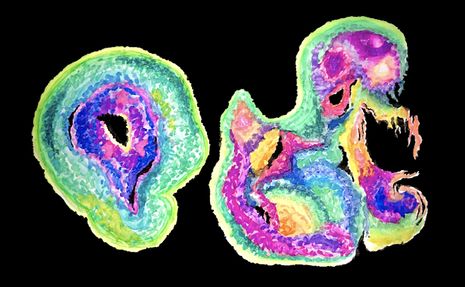Cerebral organoids: Fact and fiction
Laura Ryan explains how these “blobs of neural tissue” have revolutionised neuroscience research, and the critical ethical challenges that they face

Cerebral organoids caused a sensation when they were introduced to the world in 2013 by pioneering Cambridge researcher Dr Madeline Lancaster. Their use has raised some of the most interesting and pressing ethical dilemmas in modern biology, cutting right to the heart of our conceptions of consciousness. But to understand the moral issues – first it’s necessary to understand what these tiny blobs of tissue are – and what they are not.
“Cerebral” refers to the cerebral cortex: the outermost layer of neural tissue in the human brain, and the seat of cognition. Thinking, perceiving, language, consciousness itself – they’re all reliant on the cerebral cortex.
So what’s an organoid? Cerebral organoids are 3D blobs of neural tissue – about the size of a pomegranate seed – grown in the lab from pluripotent stem cells. These cells, which are able to “differentiate” into other cell types, are deposited into a gel for structural support. Over several months, the maturing organoids start to exhibit a diverse array of different types of neurons, and self-organise to form internal structures that mimic those of the human brain. The neurons begin to connect, and even start to spontaneously fire electrical signals.
While it may be hard to believe that these little globules could cause such excitement, their significance is hard to overstate. In many research areas, animal brains are poor substitutes for human ones. They don’t develop in the same ways, they aren’t as complex, and there are many neurological and psychiatric disorders that we haven’t identified in rodents. Until organoids came along, researchers relied on post-mortem human brain samples, which are nigh on impossible to manipulate experimentally, or small 2D populations of neurons kept alive in dishes.
The advent of cerebral organoids was predicted to revolutionise the field. So have they lived up to the hype? For the most part, yes! Published papers making use of cerebral organoids tackle both diseases associated with brain development, (schizophrenia, microcephaly, and autism-spectrum disorders), and also with neurodegeneration (early-onset Alzheimer’s).
“While it may be hard to believe that these little globules could cause such excitement, their significance is hard to overstate”
But it isn’t just neurological disorders that researchers are modelling. Watching cerebral organoids develop presents the opportunity to chart healthy human brain development as never before.
Recently, CRISPR/Cas9 technology was used to create organoids that mimic the brains of Neanderthals. The cells used to generate the organoids were genetically edited to carry a mutation that distinguished the Neanderthals from our own ancestors. The resulting “Neanderthal” organoids were smaller and more wrinkled than those derived from modern human cells. One author speculated that our variant of the gene affected the way that early humans processed information, as compared to their Neanderthal kin.
But there is an elephant in the room – is this ethical? Are the organoids conscious? Could they be?
There is near total consensus amongst those researchers, ethicists, and philosophers that no, cerebral organoids are not conscious, nor are they imminently likely to be. They are still primitive in nature, even compared to the brains of mice. To speak of “mini-brains” – a phrase often used in the media – is misleading. It understandably conjures an image of thinking (and perhaps suffering) developed minds unnaturally bound in their gel. A more accurate comparison would be early foetal neural tissue. But that’s not to say that the ethical issues surrounding this technology are any less pressing.
Cerebral organoids don’t fit into pre-existing regulatory frameworks – neither rising to the level of live subjects like humans or animals, nor consisting of a mere collection of cells. Recognising this blind spot, in 2018 a team of scientists, ethicists, philosophers, and lawyers attempted to get out ahead of the rapidly progressing science and published a letter in the journal Nature presenting their concerns. The same year saw a symposium take place at the University of Oxford to build an ethical foundation for future work, with another such initiative in the US.
The first step towards an ethical framework is to define exactly how the organoids are similar, or dissimilar, to human brains, and to investigate the parameters that we could use to assess their moral status.
We know that the organoids are “functional” in that the neurons are connected, and they’re firing. However, organoids lack several essential cell types found in human brains, and don’t have a blood supply. It’s almost impossible for us to even conceptualise what kind of experience a consciousness with no sensory input could have. The development of the early brain circuitry, upon which the human mind is built, is dependent upon the input of stimuli and information.
“But there is an elephant in the room – is this ethical? Are the organoids conscious? Could they be?”
To investigate, researchers have shifted their focus away from the cellular makeup of organoids, and towards their electrical activity. Consciousness assessments have been adapted from tests that already exist for medical use, for example to measure the brainwaves of comatose patients. One idea from University of California researcher Alysson Muotri is to anaesthetise the organoids to determine whether certain electrical signals disappear. But there’s no consensus regarding how to apply these sorts of tests to organoids (which exhibit weak electrical activity), and little agreement on how to interpret the results. Without a unified theory of what consciousness consists of, it will be very difficult to assess. Nonetheless, over the next decade characterisations of organoids’ electrical activity will become more fruitful, and are likely to form the basis for assessments of their status.
What about the future? Bioethicist Insoo Hyun predicted in an online essay that within the next five years we will see the creation of larger organoids with networks of blood vessels, and a greater diversity of brain cell types. Already it has been demonstrated that human organoids can be successfully grafted onto the brains of rodents, which do have functional nervous systems and sensory organs, raising a whole host of additional ethical dilemmas.
Of course, the argument can be made that not engaging in research with the potential to alleviate suffering for so many is unethical in itself. Neurosurgeon Donald O’Rourke, who uses organoids in his attempts to combat an aggressive type of brain cancer, explained “I’m dealing with a deadly disease that kills people in 15 months. Here we’ve developed an advanced diagnostic tool to evaluate in real time what therapies might be beneficial. In my mind, that solves ethical problems.”
So it all comes down to this; the more human the organoids become, the more useful they are. But where’s the tipping point – where what we stand to gain is outweighed by what we stand to lose? And how will we know when we’ve reached it?
 News / Eight Cambridge researchers awarded €17m in ERC research grants27 December 2025
News / Eight Cambridge researchers awarded €17m in ERC research grants27 December 2025 News / Clare Hall spent over £500k opposing busway 24 December 2025
News / Clare Hall spent over £500k opposing busway 24 December 2025 Comment / League tables do more harm than good26 December 2025
Comment / League tables do more harm than good26 December 2025 News / Caius mourns its tree-mendous loss23 December 2025
News / Caius mourns its tree-mendous loss23 December 2025 Comment / The ‘class’ of Cambridge24 December 2025
Comment / The ‘class’ of Cambridge24 December 2025










